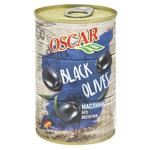olive Marmarabirlik canned 450g Turkey
-
 Auchan Kyiv Lugova 12
Auchan Kyiv Lugova 12
-
 Auchan Pochaina
Auchan Pochaina
-
 Auchan, Velyka Kiltceva 4
Auchan, Velyka Kiltceva 4
-
 Auchan Kiev Academic Glushkov 13B
Auchan Kiev Academic Glushkov 13B
-
 Auchan Kiev Hnata Khotkevycha, 1Б
Auchan Kiev Hnata Khotkevycha, 1Б
-
 Auchan Kyiv Antonovycha 176
Auchan Kyiv Antonovycha 176
-
 Auchan Kyiv Sim'i Sosninykh, 17
Auchan Kyiv Sim'i Sosninykh, 17
-
 Auchan Lviv Sokilnyky, Stryiska 30
Auchan Lviv Sokilnyky, Stryiska 30
-
 Auchan Dnipro Nyzhniodniprovs'ka 17
Auchan Dnipro Nyzhniodniprovs'ka 17
-
 Auchan Kyiv Bilychi
Auchan Kyiv Bilychi
-
 Auchan Chernivtsi Khotyns'ka, 43
Auchan Chernivtsi Khotyns'ka, 43
-
 Auchan Zhytomyr Kievskaya, 77
Auchan Zhytomyr Kievskaya, 77
-
 Auchan Odesa
Auchan Odesa
-
 Auchan Rive Gauche Zdolbunivs'ka 17
Auchan Rive Gauche Zdolbunivs'ka 17
More information
Olives are too bitter to be eaten right off the tree and must be cured to reduce their intrinsic bitterness. Processing methods vary with the olive variety, region where they are cultivated, and the desired taste, texture and color. Some olives are picked unripe, while others are allowed to fully ripen on the tree. The color of an olive is not necessarily related to its state of maturity. Many olives start off green and turn black when fully ripe. However, some olives start off green and remain green when fully ripe, while others start of black and remain black. In the United States, where most olives come from California, olives are typically green in color, picked in an unripe state, lye-cured, and then exposed to air as a way of triggering oxidation and conversion to a black outer color. Water curing, brine curing, and lye curing are the most common treatment processes for olives, and each of these treatments can affect the color and composition of the olives. From a botanical standpoint, olives belong to a very special group of fruits called drupes. Drupes are fruits that have a pit or stone at their core, and this pit is surrounded by a larger fleshy portion called the pericarp. Other drupes commonly found in diets worldwide include mango, cherry, peach, plum, apricot, nectarine, almond, and pistachio.



















